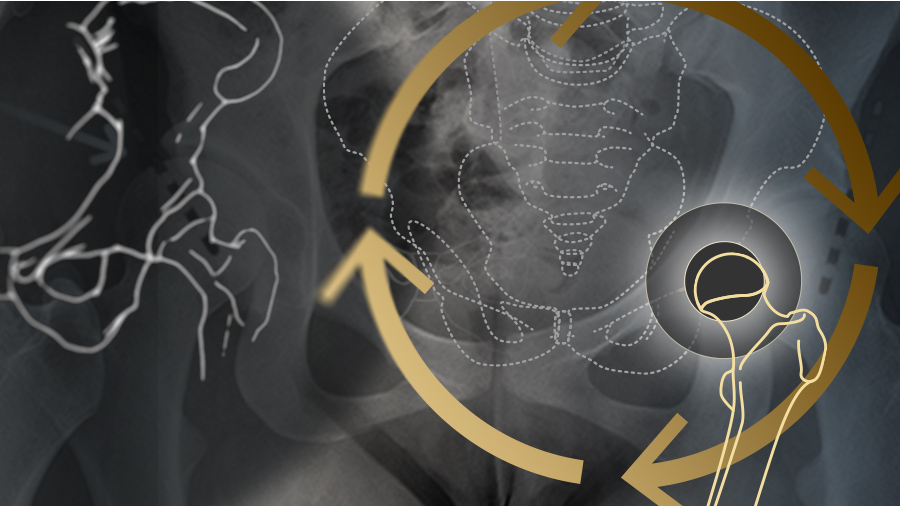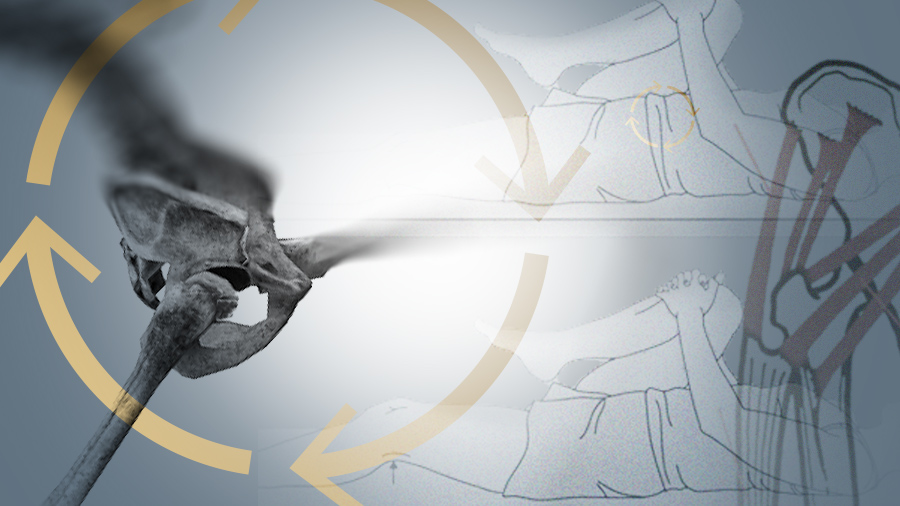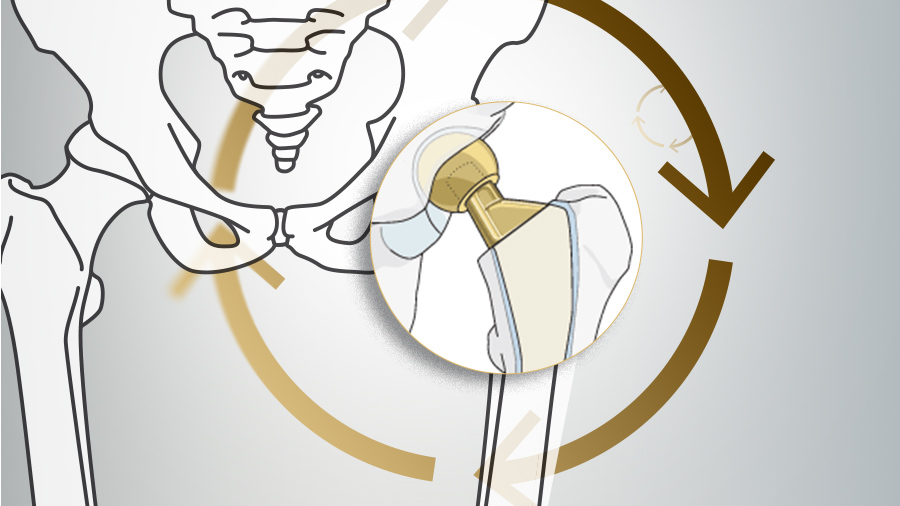Patients with hip dysplasia
Patients with developmental dysplasia of the hip (DDH) are particularly challenging for surgeons performing total hip arthroscopy (THA). Not only is this group more prone to complications, but surgically addressing structural abnormalities can result in significant lengthening of the femur during THA. Restoring equal leg length to obtain functionality is possible and several surgical techniques have been successful.
Developmental dysplasia of the hip (DDH) is a misalignment or deformation (congenital or developmental) of the hip joint [1]. Women are eight times more likely than men to have the condition and it is the most common source of hip osteoarthritis in women younger than 40 years old [2]. Clinical severity ranges from barely detectable to frank dislocation, and can occur bi- or unilaterally [3]. Incidence rates have been estimated to be around 5 per 1,000 hips [4]. It is also a risk factor for the development of hip osteoarthritis [5].
Classification of dysplastic hips
There are two accepted reliable classification systems [6] for dysplastic hips: Crowe [7] and Hartofilakidis [8]. Eftekhar and Kerboul classifications were found to not be as reliable by Brunner et al [9].
Read the full article with your AO login
- Classification of dysplastic hips
- Complexity necessitates planning
- Preoperative X-rays and templating
- A toolbox of techniques
- Conclusion
- References
Additional AO resources
Access videos, tools, and other assets to learn more about this topic.
- Upcoming events: AO Recon Course finder
Contributing experts
This series of articles was created with the support of the following specialists (in alphabetical order):

Biju Benjamin
University College London Hospital
London, United Kingdom

Babar Kayani
University College London Hospital
London, United Kingdom

Jurek Pietrzak
University College London Hospital
London, United Kingdom
This issue was created by Word+Vision Media Productions, Switzerland
References
- Shaw BA, Segal LS. Evaluation and referral for developmental dysplasia of the hip in infants. Pediatrics. 2016 Dec;138(6).
- Committee on Quality Improvement, Subcommittee on Developmental Dysplasia of the Hip. Clinical Practice Guideline: Early Detection of Developmental Dysplasia of the Hip. AAP Policy. 2000 105 (4): 896–905.
- Wikipedia. Hip dysplasia. Available at: https://en.wikipedia.org/wiki/Hip_dysplasia#Acquired. Accessed June 17, 2017.
- Bialik V, Bialik GM, Blazer S, et al. Developmental dysplasia of the hip: a new approach to incidence. Pediatrics. 1999 Jan;103(1):93–99.
- Jacobsen S, Sonne-Holm S. Hip dysplasia: a significant risk factor for the development of hip osteoarthritis. A cross-sectional survey. Rheumatology (Oxford). 2005 Feb;44(2):211–218.
- Yiannakopoulos CK, Chougle A, Eskelinen A, et al. Inter- and intra-observer variability of the Crowe and Hartofilakidis classification systems for congenital hip disease in adults. J Bone Joint Surg Br. 2008 May;90(5):579–583.
- Crowe JF, Mani VJ, Ranawat CS. Total hip replacement in congenital dislocation and dysplasia of the hip. J Bone Joint Surg Am. 1979 61:15–23.
- Hartofilakidis G, Stamos K, Ioannidis TT. Low friction arthroplasty for old untreated congenital dislocation of the hip. J Bone Joint Surg Br. 1988 70:182–186.
- Brunner A, Ulmar B, Reichel H, et al. The Eftekhar and Kerboul classifications in assessment of developmental dysplasia of the hip in adult patients. Measurement of inter- and intraobserver reliability. HSS J. 2008 Feb;4(1):25–31.
- Korkmaz O, Malkoç M. In: Spasovski D, ed. Total Hip Replacement in Developmental Dysplasia of the Hip: Pitfalls and Challenges, Developmental Diseases of the Hip - Diagnosis and Management. 2017. InTech, DOI: 10.5772/67479. Available from: https://www.intechopen.com/books/developmental-diseases-of-the-hip-diagnosis-and-management/total-hip-replacement-in-developmental-dysplasia-of-the-hip-pitfalls-and-challenges .
- Benjamin B. Management of limb length problems during total hip replacement for patients with developmental dysplasia of hip. (Publication pending).
- Krueger C. Adult Dysplasia of Hip. OrthoBullets. Available at: http://www.orthobullets.com/recon/5008/adult-dysplasia-of-the-hip. Accessed June 17, 2017.
- Chu YM, Zhou YX, Han N, et al. Two Different Total Hip Arthroplasties for Hartofilakidis Type C1 Developmental Dysplasia of Hip in Adults. Chin Med J (Engl). 2016 Feb 5;129(3):289–294.
- Dapuzzo R, Sierra RJ. Acetabular considerations during total hip arthroplasty for hip dysplasia. Orthop Clin North Am. 2012 Jul;43(3):369-75.
- Boisgard S, Descamps S, Bouillet B. Complex primary total hip arthroplasty. Orthop Traumatol Surg Res. 2013 Feb;99(1 Suppl):S34–42.
- International Hip Dysplasia Institute. Hip Joint Replacement Surgery for Hip Dysplasia. Available at: http://hipdysplasia.org/adult-hip-dysplasia/adult-treatments/hip-joint-replacement-surgery-for-hip-dysplasia/. Accessed June 17, 2017.
- Argenson JN, Flecher X, Parratte S, et al. Anatomy of the dysplastic hip and consequences for total hip arthroplasty. Clin Orthop Relat Res. 2007;465:40–45.
- Liu R, Liang J, Wang K, et al. Sciatic nerve course in adult patients with unilateral developmental dysplasia of the hip: implications for hip surgery. BMC Surg. 2015;31;15(1):1.
- Lewallen DG. Neurovascular injury associated with hip arthroplasty. Instr Course Lect. 1998;47:275–283.
- Meermans G, Malik A, Johan Witt, et al. Preoperative radiographic assessment of limb-length discrepancy in total hip arthroplasty. Clin Orthop Relat Res. 2011 Jun; 469(6): 1677–1682.
- Charnley J. The long-term results of low-friction arthroplasty of the hip performed as a primary intervention. 1972. Clin Orthop Relat Res. 1995 Oct;(319):4–15.
- Bao N, Meng J, Zhou L, et al. Lesser trochanteric osteotomy in total hip arthroplasty for treating CROWE type IV developmental dysplasia of hip. Int Orthop. 2013 Mar;37(3):385–390.
- Reikeraas O, Lereim P, Gabor I, et al. Femoral shortening in total arthroplasty for completely dislocated hips: 3-7 year results in 25 cases. Acta Orthop Scand. 1996 Feb;67(1):33–36.
- Sener N, Tözün IR, Aşik M. Femoral shortening and cementless arthroplasty in high congenital dislocation of the hip. J Arthroplasty. 2002 Jan;17(1):41–48.
- Neumann D, Thaler C, Dorn U. Femoral shortening and cementless arthroplasty in Crowe type 4 congenital dislocation of the hip. Int Orthop. 2012 Mar;36(3):499–503.
- Koulouvaris P, Stafylas K, Sculco T, et al. Distal femoral shortening in total hip arthroplasty for complex primary hip reconstruction. A new surgical technique. J Arthroplasty. 2008 Oct;23(7):992–998.
- Yoon PW, Kim JI, Kim DO, et al. Cementless Total Hip Arthroplasty for Patients with Crowe Type III or IV Developmental Dysplasia of the Hip: Two-Stage Total Hip Arthroplasty Following Skeletal Traction after Soft Tissue Release for Irreducible Hips. Clin Orthop Surg. 2013 Sep; 5(3): 167–173. Available at: https://www.e-sciencecentral.org/articles/SC000004506. Accessed June 18, 2017.
- Charity JA, Tsiridis E, Sheeraz A, et al. Treatment of Crowe IV high hip dysplasia with total hip replacement using the Exeter stem and shortening derotational subtrochanteric osteotomy. J Bone Joint Surg Br. 2011 Jan;93(1):34–38.
- Pietrzak J. Management of limb length discrepancy after total hip arthroplasty. (Publication pending).




